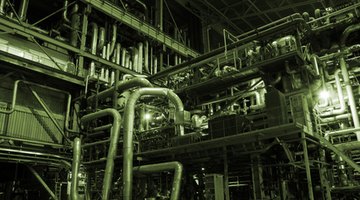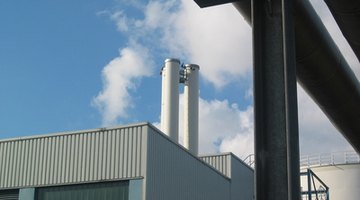How to Calculate Boiler Steam Flows
Modern steam boilers create easily utilized energy for many heating, processing, and mechanical and electrical power-generation applications. They can derive their incoming energy from many types of fuels: electricity, co-generation, sunlight, nuclear and waste heat from other processes.

Being able to calculate boiler steam flows from any of the parameters surrounding a boiler, including boiler horsepower, kilowatts, fuel-flow rates, feedwater flow, combustion air flow, or steam use data provides a complete picture of boiler performance.
Things You Will Need
- Calculator
- Boiler system parameters
-
Use boiler horsepower to calculate steam flow. Boiler horsepower is not related to mechanical horsepower. It is a boiler industry rating that predicates the amount of saturated steam a boiler will generate starting with water at 212 degrees Fahrenheit and 0 pounds per square inch gauge (psig--meaning atmospheric pressure) and ending with steam at 212 F and 0 psig. For example, if a boiler is rated at 50 bhp, then it will produce 50 bhp x 34.5 pounds per hour (lb/hr) = 1,725 lb/hr of steam under these conditions.
-
Use btu/hr (British thermal units/hour) heat input rate to calculate boiler steam flow. It takes 970.28 btu/hr to produce 1 pound of steam at the above conditions. If 50 million btu/hr are being applied to the boiler, divide by the 970.28-btu/lb to yield 51,531-lb/hr steam flow. This is an average industrial boiler.
-
Calculate boiler steam flow with a known kilowatt hour (kWh) usage in an electrically heated boiler. If 1-kWh can produce 3.517 pounds of steam at the above zero-psig and 212-deg-F conditions, then 1,000 kWh will produce 3,517 lb/hr of steam.
-
Compute the flow rate of steam from a boiler based on burning 20 gallons/hour of No. 6 fuel oil, assuming normal 85 percent boiler combustion efficiency. The accepted btu/gallon conversion rate for No. 6 fuel oil is 150,000 btu/gal. A boiler burning 20 gallons per hour would produce [(150,000 btu/gal x 20 gal/hr) / 970.28 btu/lb] x 0.85 (efficiency) for a total of 2,628.1 lb/hr of steam.
-
Calculate the combustion-air mass required to burn the 20 gallons of No. 6 fuel oil above. Since the air-fuel stoichiometric ratio is 14.4 pounds of air per pound of fuel, the boiler’s burner would need 20 gallons x 7.95 lb/gal for No. 6 fuel oil, or 2,289 pounds of air to burn the oil. This would in turn yield a total flow of 2,628.1 lb/hr of steam. Therefore, knowing the amount of combustion air flow during an hour for a given boiler, you can back-calculate to compute the steam flow. This means a boiler will produce about 2,628.1 lb/hr / 2,289 lb/hr of combustion air consumed, or about 1.15 pounds of steam for every pound of air.


Tip
Calculating steam flow using different parameters tells the operator the complete story about his boiler. There are large boilers burning several different fuels simultaneously where combustion air flow can be used to infer a steam flow. The interesting thing about boilers is that once the air-mass-to-steam-mass flow ratio has been determined for a given boiler, all carbon-based fuels will require just about the same amount of air to produce 1 pound of steam, whether they are wood, coal, oil or natural gas. This phenomenon makes it easy to compute steam production from total air flow rate when a combination of fuels is being used at once.
The Drip Cap
- Modern steam boilers create easily utilized energy for many heating, processing, and mechanical and electrical power-generation applications.
- Being able to calculate boiler steam flows from any of the parameters surrounding a boiler, including boiler horsepower, kilowatts, fuel-flow rates, feedwater flow, combustion air flow, or steam use data provides a complete picture of boiler performance.
- Use btu/hr (British thermal units/hour) heat input rate to calculate boiler steam flow.
- A boiler burning 20 gallons per hour would produce [(150,000 btu/gal x 20 gal/hr) / 970.28 btu/lb] x 0.85 (efficiency) for a total of 2,628.1 lb/hr of steam.
- Since the air-fuel stoichiometric ratio is 14.4 pounds of air per pound of fuel, the boiler’s burner would need 20 gallons x 7.95 lb/gal for No.
References
Resources
Writer Bio
Pauline Gill is a retired teacher with more than 25 years of experience teaching English to high school students. She holds a bachelor's degree in language arts and a Master of Education degree. Gill is also an award-winning fiction author.
Photo Credits
- Boilers, ladders and pipes on power plant image by Andrei Merkulov from Fotolia.com
- Boilers, ladders and pipes on power plant image by Andrei Merkulov from Fotolia.com
- heizhaus image by Holger B. from Fotolia.com
- Steam Power Plant image by dvest from Fotolia.com
More Articles
- Heat Pump Vs. Propane Furnace Heat
- How a Pellet Stove Ignitor Works
- What Does it Cost to Run a Natural Gas Furnace Per Hour?
- What Is the Difference Between a Miller CP-300 & CP-200?
- How Many Tons Is a Heil Central Air Conditioner Unit Model CRG3-0300-PFV?
- How to Calculate Relative Carrying Capacity of Pipes



